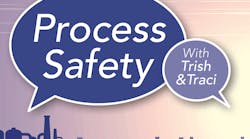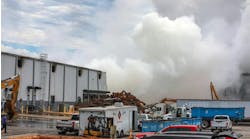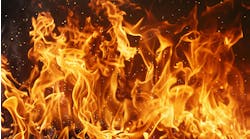Podcast: Operating During A Pandemic And Process Safety Documentation
This edition of Process Safety with Trish & Traci, the podcast that aims to share insights from current incidents to help avoid future events, kicks off with advice on handling operations during the COVID-19 pandemic. Also covered: process-safety documentation best practices.
Transcript
Traci: Welcome to this edition of Process Safety with Trish & Traci, the podcast that aims to share insights from current incidents to help avoid future events. I'm Traci Purdum, senior digital editor with Chemical Processing and as always I'm joined by Trish Kerin, the director of IChemE Safety Centre. Well, Trish, we are in the midst of a pandemic with the COVID-19. It's business as usual for the likes of me but not so much for the manufacturing world. Before we launch into today's topic, I wanted to kind of pick your brain a little bit in terms of the safety concerns and what it means for chemical engineering and chemical processing plants.
No worries! Subscribe and listen whenever, wherever.
Now, the big challenge here is with so many people that are potentially going to be impacted by being made ill by the virus, we might actually have resourcing issues at our facilities. And this is really concerning because if we don't have the right number of people with the right competencies running our plants, then we are exposing ourselves to an enormous risk. And so, what I would say to companies right now is go out and take a look at your emergency response plan. Take a look at your facility resourcing, understand whether you've got the competencies you need in these challenging times. And unfortunately, you have to make some tough decisions that shutting down a part or all of the plant potentially because you can't safely resource it. But that's certainly better that the alternative of having a major incident. We certainly can't afford to do that at the moment. We need to make sure that we keep everybody safe and that includes our emergency responders as well. They have a job to do but we need them in other parts of that community right now looking after vulnerable people in this situation.
Traci: All great points. And actually, it ties really well into our topic that we wanted to discuss today which is documentation. Process documentation and other process safety information play a key role in process safety management. Nearly every governing authority as well as insurance providers require process safety documentation. Who is responsible for this documentation?
Trish: You know, that's actually going to vary depending on what jurisdiction you're in or what laws you're operating under. However, as an overarching principle, the company is responsible for producing process safety-related documentation for our facilities. Now, that responsibility is then going to be cascaded down to individuals within that organization. So, I would suggest people like the plant manager of a particular facility is the person responsible for making sure all appropriate documentation is in place, current, and accurate for their facility. Because at the end of the day, they're actually the ones accountable for running that facility safely. So I would say that it comes down to the site leader. That, to me, is going to be the person really responsible. As I said, different jurisdictions are going to have different legal definitions on who is actually legally responsible for it. But as a general principle, if you're the boss, it's your job.
Traci: Now, it makes sense. Obviously, they're in the plant. They're responsible for it. They should be responsible for the documentation. But I have read, I have heard that sometimes this is outsourced. Are there benefits to that or are there challenges? Is it insane to do that?
Trish: Well, there are both benefits and challenges to doing it. So, there's a range of different safety documentation that needs to be maintained for our facility to be able to operate safely. Now some of that material may well be best documented by technical specialists, and you may not have those technical specialists in your organization. For example, not every facility is going to have its own fire safety engineer expert that can do a fire safety study. So, you need an expert to do those sorts of assessments. You need experts to do some detailed level of risk assessments. You may not have that technical capability within your organization, and that's okay. What you need to do is make sure you have access to that technical capability. And that is where we need to be working with our consultants and our engineering advisors all over the world we use to help us document our information. What I would say though is you need to remember who has to own the documentation at the end of the day. And again, that's back to the company and the plant manager. So just because you outsource the production of the documentation doesn't mean you're outsourcing the responsibility of the documentation. It is still yours. You are still accountable. You are still responsible for what's in that and for making sure it's implemented and that the plan is operated in a safe way. So whilst there are certainly advantages and benefits to having others develop some of that information for you, the challenge you've got to overcome is just because you've outsourced it, doesn't mean you've outsourced the risk. It's yours. You have to take care of it. You have to know what's actually in it, and you have to understand how the conclusions in those documents were reached. It's not enough just to say oh, but they told me. No, you actually need to understand this information as well.
Traci: Excellent points. And talking about the elements that are in there, what are the key elements needed in proper documentation?
Trish: Well, I think there's a couple of different elements that I think are critically important. One of them is holding information around your risk. So that is what are your hazards? You need to document your hazards. What are the consequences that could eventuate from those hazards? What's the likelihood of those consequences eventuating? And that's actually your risk equation, consequence and likelihood. And what are your controls? What do you need to put in place to prevent those hazards turning into those consequences? And lastly, how do you know your controls work? So how are you monitoring and providing assurance that the controls are actually doing what you think they're doing. So how do you really complete that entire risk picture? I think that's one key part of what's required to be documented. And things like the hazards includes things like the quantities and types of dangerous substances. The sort of energy sources you have on your facility, all those sorts of things. So, I've summed it up very succinctly there, but there's actually a lot of information in that risk equation.
The second part that I think is really, really important is the basis of safety for the facility. Now, the basis of safety is a document that we like to...a term we like to use to describe a document that basically describes why the plant was built like it was. What were the assumptions in the design that led us to use...react to design A rather than react to design B? What was thought about what are they key elements in that design and how are we then going to ensure that they remain and have the integrity we need them to have?
So, this comes back a little bit into our discussion in the last podcast about inherently safer design. What decisions have been made and why? So that when it comes time for someone to do a management of change and they want to change something, we actually know why it was there in the first place. Because if we don't understand clearly why it was there, we might make a change without understanding the true consequences of what we're doing.
And then, lastly, I touched on it earlier, the emergency response and business continuity. If something does go wrong, what are you going to do about it? How are you going to cope with it? How are you going to manage it? What resources do you have in place? What resources do you have available? But sometimes, we won't even have all the resources in place for an emergency but we know we have them available through mutual aid type agreements or the like.
So, these are I think the key things that absolutely need to be documented for any facility. Now, if your facility is very simple, your documentation is going to be simple. Doesn't need to be overly complex but it needs to cover what your basis of safety is and what your emergency response are for your facility, I think.
Traci: You and I have discussed in the past in terms of locations and knowing where you're building is in terms of are there hurricane risks? Are there any other risks that would make sense for documenting? Can you talk a little bit about making sure you address community details and even the design of your building?
Trish: This is a whole other big area of it. So, you know, we've talked about hurricane risk, you're right. But what about the risk of the train line that runs right beside your facility? Now, that can be a risk from either a train derailment, which may or may not be a credible scenario in your particular area, but also things like if you have leak of flammable substance and there's a train coming, that’s one significant ignition source for you. So, you know, the risk that not only the facility poses to the community but also outside some of the things that the community could pose to the facility or neighboring facilities as well can also have quite a big impact. So, we do need to understand all of these sorts that are going on around our area. You know, we saw with the West Texas explosion that occurred, there was some school buildings that were quite significantly damaged in that explosion. And there was I think a retirement home quite nearby as well. So, the community details of what is around your facility. You need to actually understand what your sensitive populations are, and we need to deal with what those sensitive populations are. Because we don't necessarily want someone building a high-rise apartment complex that's going to be filled with a thousand people right next to our refinery.
Strangely enough, organizations try to do this. And that's when you need to have some sort of way to do your land-use planning so we don't end up with those encroachment issues. But definitely, we need to be aware of the hazards that are there. But likewise, there might also be very valid reasons to be build right beside a train line. You might do a whole lot of transportation of your materials by train. That's great. That keeps it off the road because there are hazards with road transportation. So, we need to make sure that understand and balance, two inherently safer design principles, the risks that we have on our facility. So, making sure you understand what's around you and making sure...you then need to actually feed your safety information back to the people around you. What do the community need to do in case of an emergency incident? What happens if they hear your siren go? What response do they need to take to keep them safe? Those sorts of details as well need to be clearly documented and then shared.
Traci: An interesting question with that, do you make documentation available for the public so that they can access what to do?
Trish: In certain jurisdictions, it's a legal requirement. It must be made available to the public. Now, that's not to say you provide them with everything. We still need to make sure we have security provisions covered appropriately because we don't want people to know all of the details about how they could harm our facility, for example. But they may need to know the types of substances we have because they then need to have a response of what they need to do to protect themselves as well, and keep themselves out of harm's way.
So, typically, what we see is often a summary document is produced by companies. It has enough detail of basically what the community need to do in an emergency without enough detail how to go and do something bad to the facility if I had this information. So, it does need to be a little bit of a balance of what needs to be there. And then typically we see these made available at things like public libraries, for people within immediate areas they receive them as a letter drop, so that they actually have their little flier that says if I hear this siren, here's what I need to do to keep myself and my family safe. And that's really important. But as I said, there is this balance with some information we just can't share. But there's other information that we need to share to keep people safe outside of our fence lines.
Traci: Great points made there. But in terms of the actual full documentation, is there a place that is best to house these? Is there a central location that first responders or somebody else in the plant who is not as close to the documentation process knows exactly where to get these documents, get their hands on it so they can act quickly?
Trish: Again, different jurisdictions will have different requirements. I think what is good in practice though is all work is on your facility. Actually, should have access to all appropriate safety information. So that actually means they should be able to access your process safety documentation. Now, that doesn't mean everybody in the facility needs to be able to log on to your maintenance management system and assess personally whether things have been tested to the right frequency and what their results were. I'm not saying that's what we need to have...that everybody needs to have access to. But people need to have access to the risk register. What are the hazards? What are the potential consequences? What's the likelihood? What are the controls and how are they managed? So that I can see, oh, I think there's a problem here. I can check whether this could be a more significant issue. I can ask someone. I can have a look at that information.
In terms of jurisdictions, as I said it's legally required to have that material available to people on the facility. Then, you need to make sure you've got the emergency response plan available particularly for your emergency responders as they come through the gate. And often, we think the emergency responders, they're going to come riding in on their big white horse to save the day. And they're going to come through bursting through the gates and come and save us. Emergency responders quite rightly will stop at the gate and want to know all the details of what's there because they're of no use to anybody if they're injured or killed. So, they, as the first step, will attempt to protect themselves, and you cannot blame them for doing that because we need them alive to help us. So, often, you will have a special data pack that you give to emergency responders at the gate that explains the quantity of chemicals you have, the type of chemicals, where they're housed, and how they're housed so that they can make intelligent decisions about what they do and how they respond to it. And these are really important different sorts of documents that you need to have as part of the emergency response for the emergency responders.
But overall, you know, we need to be moving to the point where if we're trusting someone to operate a plant, then surely, we should be trusting them with the important information they need to operate the plant. Keeping that information away from the operators, away from the people that are at the in the trenches so to speak, making safety decisions every day is not a really smart way to operate a facility. Knowledge is power and the people operating the facility need the power. It needs to not be kept from them.
Traci: Absolutely. Knowledge is power, for sure. You already touched on it with the management of change and keeping things up-to-date, but is there a revision schedule on these or is it a monthly revision of these plans? Is it a yearly? I know sometimes people finish the project and put it away and don't think about it until it's due again.
Trish: Yeah. It's going to be different review period depending on what sort of documentation it is. So, for example, I would suggest that an emergency response plan needs to be revisited at least annually. Now, depending on where you are again, there might be legal requirements for you to make. So, take those legal requirements as the absolute minimum requirements you need to meet, then what I'm suggesting some of them maybe in excess of that. But, first of all, you should be doing emergency response exercises annually at least. And from that, you'll learn some things. Some things might not have gone as you expected. You might need to go and revisit the client and revise it. So, I would suggest emergency response plans at least annually.
When it comes to things like risk assessments, that's a little bit harder. So, if we're doing a management of change activities, then as we do a change, we should be assessing our risks. And so that would require us to do another risk assessment on a particular area anyway. Over time, we start to get these cumulative changes occur and we need to make sure that we assess the entire facility again. And a general rule of thumb is that a full risk assessment should be reconducted on a facility every five years. Now, you'll also have some procedures that are important information that are part of maintaining your controls and those sorts of things. Some of those may have much shorter review periods. There might be review periods every 12 months. Some of them might even be every six months depending on what the procedure is, how important it is, and where it's placed within your organization and how it's used. There's probably not really much point reviewing a procedure every six months if you only ever do the task every two years. So, you know, you need to understand a lot of these factors around what you're doing to then make a decision.
And then, you should clearly document your revision schedule so that you know what needs to be done when. Every procedure should have a review by date on it, a date it was last reviewed and when it should be reviewed by next. And in fact, one of your lead process safety metrics or indicators should actually be you reviewing your procedures as scheduled. Because if you're not, then that shows that there's a little part of your system that's drifting out of control and you need to bring that back into control. So there's no one answer. Depending on what the information is will depend on how frequently you need to review it. Again, we can take a risk-based approach to this and say, "Well, this is a low risk document. It doesn't need to be reviewed frequently. This is a high-risk document. It does need to be reviewed more frequently."
Traci: Again, sage advice there. Any final thoughts? I know we've covered a lot of what needs to be covered in terms of documentation but do you have final thoughts that we can leave our listeners with?
Trish: I guess one final thought on documentation is think about who it's being written for when you write it. So, if you typically have a high school educated level operator in your facility, don't write them a long document full of legal terms. That's not going to work. The document needs to be written in a way that the people that need to use it can understand it. And this also means it needs to be in a language that people can understand. So, we need to always remember safety information must be provided in an appropriate language for the people that need it. If you have a large Spanish-speaking contingent, then you need to be thinking about having some documents in Spanish for them. Because you can't necessarily expect that they're going to be able to interpret adequately documents only in English or vice versa or any other language. You really need to focus on what's known in training as language literacy numeracy, making sure that all your documentation is written at a level that the people that need it can actually understand it. And not everybody may have your level of language literacy and numeracy.
Traci: Well, once again, Trish, you always provide us with excellent common sense approach to process safety. Unfortunate events happen all over the world and we will be here to discuss and learn from them. On behalf of Trish, I'm Traci and this is Process Safety with Trish & Traci.
Trish: Stay safe.
Check out all the episodes of Process Safety With Trish & Traci.
Want to be the first to know? Subscribe and listen to Process Safety With Trish & Traci on these platforms








